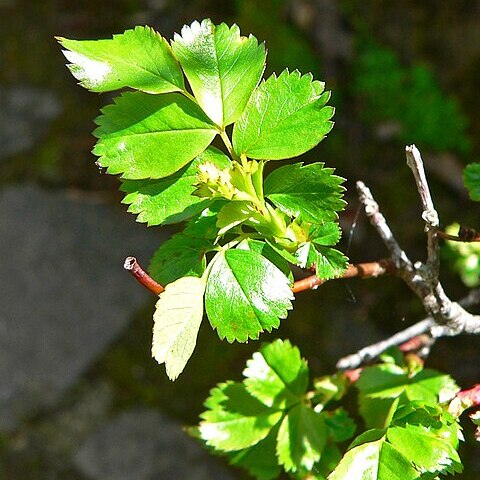Shrubs, loosely clustered or in dense thickets. Stems ascending to erect, (2–)4–20(–25) dm, openly branched; bark ± glaucous when young, dark reddish brown or dull red with age ?outer layer may exfoliate as thin ash gray peel?, glabrous; infrastipular prickles usually paired, erect, rarely curved, usually subulate, 2–10 × 2–4 mm, ?base glabrous?, internodal prickles rare or absent. Leaves 5–10(–13) cm; stipules 8–22 × 2–5 mm, auricles flared, 2–5 mm, margins usually entire, sometimes erose or lobed, ?finely ciliolate to ciliate?, eglandular, surfaces glabrous or sparsely pubescent, sparsely stipitate-glandular or eglandular; petiole and rachis sometimes with pricklets, glabrous or hairy ?hairs to 1 mm?, sometimes stipitate-glandular; leaflets 5–7(–9), terminal: petiolule 8–12 mm, blade elliptic-ovate, (15–)20–45(–60) × 9–16(–20) mm, ?widest at or below middle?, membranous, base cuneate to obtuse, margins 1(–2)-serrate, teeth 12–22 per side, ?on distal 3/4–4/5 of margin?, acute, eglandular, apex acute, sometimes obtuse, abaxial surfaces pale green, usually sparsely pubescent, eglandular, adaxial green, dull, glabrous, rarely puberulent. Inflorescences corymbs, sometimes panicles or solitary flowers, 1–12-flowered. Pedicels erect, sometimes recurved, slender, 10–22 mm, usually glabrous, sometimes finely puberulent, eglandular, rarely stipulate-glandular; bracts 2–3, lanceolate, 8–14 × 3–6 mm, margins entire, sometimes serrate, irregularly stipitate-glandular and/or erose, surfaces glabrous or pubescent, eglandular. Flowers 2.4–3.8 cm diam.; hypanthium ovoid-urceolate, 3–5 × 2.5–3.5 mm, glabrous, rarely setose, eglandular, neck (0–)0.5–1 × 2 mm; sepals spreading, ovate-lanceolate, 10–17 × 1.5–3 mm, tip 3–7(–10) × 1.5–2.5 mm, margins entire, abaxial surfaces sometimes puberulent, densely or sparsely stipitate-glandular, rarely eglandular; petals single, pink to deep pink, 12–18 × 10–18 mm; ?stamens 75?; carpels 22–35, styles exsert 1–2 mm beyond stylar orifice (1 mm diam.) of hypanthial disc (3.5 mm diam.). Hips scarlet, globose, sometimes subglobose or ovoid, 7–15 × 7–13 mm, fleshy, glabrous, eglandular, rarely setose-or stipitate-glandular, neck (0–)1–1.5 × 1.5–3.5 mm; sepals persistent, erect. Achenes basiparietal, 5–35, tan, 3–4 × 1.5–2.5 mm. 2n = 14, 28.
More
A shrub. It grows 0.9-2 m high and spreads 1.2 m wide. It loses its leaves during the year. The stems arch over. The leaves are small and they have bristles at the base. The flowers are small and single. They are rose pink. The fruit are small red, shiny hips.
Can be grown by cuttings or seedlings. Seeds needs scarification.

